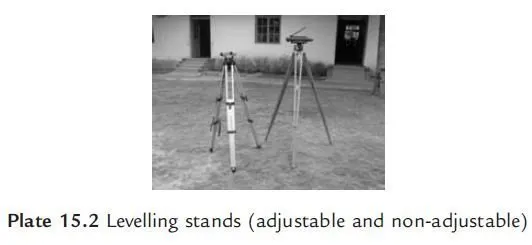A level is an instrument giving horizontal line of sight and magnifying the reading at a far away distance. It consists of the following parts:
(i) A telescope to provide a line of sight
(ii) A level tube to make the line of sight horizontal and
(iii) A levelling head to level the instrument.
The following types of levels are available:
(i) Dumpy level (ii) Wye (or, Y) level
(iii) Cookes reversible level (iv) Cushings level
(v) Tilting level and (vi) Auto level.
Dumpy Level
It is a short and stout instrument with telescope tube rigidly connected to the vertical spindle. Hence the level tube cannot move in vertical plane. It cannot be removed from its support. Hence it is named as dumpy level. The telescope rotates in horizontal plane in the socket of the levelling head. A bubble tube is attached to the top of the telescope. Figure 15.3 shows a typical dumpy level. Plate 15.1 shows its photograph.
Telescope is a tube with object glass and eyepiece. Object glass can be adjusted using the focussing screw before sighting the graduated staff held on the object. Eyepiece can be adjusted by rotating it to see that parallel is removed and cross hairs appears distinctly. Eyepiece once adjusted needs no change as long as the same person takes the readings.
Level tube is a glass tube with slightly curved shape provided over the level tube. The tube is filled with ether or alcohol leaving a little air gap, which takes the shape of a bubble. The air bubble is always at the highest point. The level tube is fixed with its axis parallel to telescope tube, so that when bubble is centred, the telescope is horizontal. The tube is graduated on either side of its centre to estimate how much the bubble is out of centre. The glass tube is placed inside a brass tube which is open from top and on lower side it is fixed to telescope tube by means of capston headed nuts. The bubble tube is adjusted with these nuts, if it is out of order.
Levelling head consists of two parallel plates with three foot screws. The upper plate is known as tribratch plate and the lower one as the trivet. The lower plate can be screwed on to the tripod stand.
By adjusting the screws the instrument can be levelled to get perfect horizontal line of sight.
Dumpy level is to be fitted to a tripod stand to use it in the field. The tripod stand consists of three legs connected to a head to which the lower plate of level can be fitted. The lower side of the legs are provided with metal shoes to get good grip with ground. Plate 15.2 shows typical level stands.
Wye or Y-Level
In this type of level, the telescope is supported in two Y-shaped supports and can be fixed with the help of curved clips. Clips can be opened and telescope can be reversed end to end and fitted. The advantage of this level is some of the errors eliminated, if the readings are taken in both the direction of telescope.
Cookes Reversible Level
In this instrument the telescope is supported by two rigid sockets into which telescope can be introduced from either end and then screwed. For taking the readings in the reversed position of telescope, the screw is slackened and then the telescope is taken out and reversed end for end. Thus it combines the rigidity of dumpy level and reversibility of Y-level.
Cushings Level
In this reversing of telescope end for end is achieved by interchanging the eyepiece and the objective piece since both collars are exactly the same.
Tilting Level
In this, telescope can be tilted through about four degrees with the help of a tilting screw. Hence bubble can be easily centered. But it needs centering of the bubble before taking every reading. Hence it is useful, if at every setting of the instrument number of readings to be taken are few.
Auto Level
The auto-level or the automatic-level is a self aligning level. Within a certain range of tilt automatic levelling is achieved by an inclination compensating device. The operational comfort, high speed and precision are the advantages of this instrument.


dump level quotation